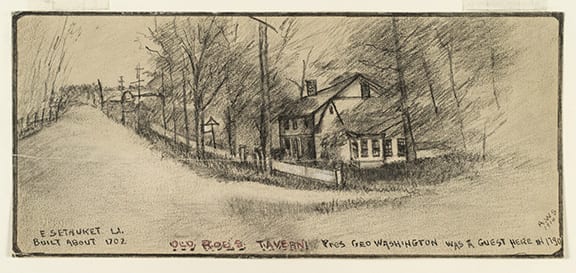By Corey Geske
Now through Jan. 16, 2020, the New-York Historical Society is featuring an exhibition Beyond Midnight: Paul Revere, while in East Setauket there’s reason to celebrate a find related to the home of courier and spy Capt. Austin Roe, known as the “Paul Revere of Long Island.”
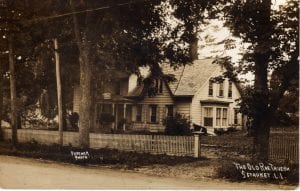
For the first time in a century, sketches of Old Roe’s Tavern in its original location in East Setauket have come to light courtesy of the New-York Historical Society (N-YHS) after an ongoing search, at my request, for catalogued entries that initially evaded art handlers. Gifted in 1954 to the N-YHS, the sketches remained unheralded for 65 years until brought to light this September on the eve of the recent fifth annual Culper Spy Day sponsored by the Three Village Historical Society, Tri-Spy Tours, The Long Island Museum and The Ward Melville Heritage Organization.
Dating from 1911 to 1917, the sketches in graphite (pencil) with touches of white chalk on buff paper are by Arthur W. Strong, an interior designer and third-generation American sign painter. At my request, they have been photographically digitized for the first time.
Spy Trail captured in Strong’s sketches
On his sketches, Strong inscribed a date of circa 1702 to the future tavern, a year before it’s now believed the first Selah Strong in Setauket built the one-story section seen to the right (east) in the top photo. The Strongs sold to the Woodhulls who, in turn, sold to the Roe family, who added the main section in 1735 and turned it into a tavern. Under cover of his livelihood as tavern-keeper, Roe acted as a courier for George Washington’s spy ring, carrying information between New York City and Setauket at great personal risk during the American Revolution, when Long Island was occupied by the British.
Among the few known views of Roe Tavern in its original location (now marked by a sign), Strong’s sketches predate Route 25A road changes that necessitated the tavern’s move a mile away in 1936. Strong’s 1914 sketch of the tavern conveys the same basic undulations of land and roadway so familiar today on the Spy Trail, which extends from Port Jefferson to Great Neck along 25A, known as the King’s Highway during the Revolution.
Today it’s known as the Culper Spy Trail after Washington’s chief spies on Long Island — Abraham Woodhull, alias Samuel Culper Sr., and Robert Townsend, Culper Jr., who provided key intelligence to Washington in 1780 that helped save West Point from Benedict Arnold’s treason. Also, thanks to the horsemanship of Roe that year, the French Navy was spared at Newport, Rhode Island, so it could sail south to assist Washington in achieving the ultimate Revolutionary War victory at Yorktown, Virginia, the following year.
In 2017, the New York State Legislature recognized the contribution of the Culper Spy Ring, and commemorative Spy Trail signs were installed by the North Shore Promotion Alliance.
Arthur Strong’s 1914 sketch provides the earliest known perspective of the Roe Tavern from the northeast looking west along the dirt road to New York City as it was likely laid out when traveled by Roe as he couriered coded messages for Washington. Riding horseback 110 miles round trip at least once a week, on roads patrolled by British soldiers and frequented by highwaymen and British spies and couriers, the danger persisted when Roe returned home where the enemy, drinking at his tavern, would hopefully drop an unguarded comment on military plans that warranted transmittal to Washington.
Washington’s room at the tavern
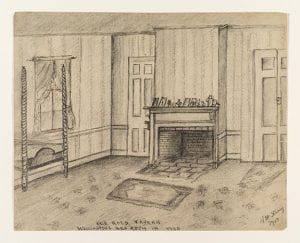
Tavern, 1917, by Arthur W. Strong,
gift of the Estate of Oscar T. Barck Sr.
Photography ©New-York Historical Society at https://www.nyhistory.org
Through Strong’s eyes, too, we see the tavern where it stood in 1790 when Washington saw it and recorded in his diary, “thence to Setakit . . . to the House of a Captn. Roe which is tolerably dect. [decent] with obliging people in it.” Washington slept there on the evening of April 22, 1790 during a post-war tour of Long Island to thank those, like Roe, who spied for the American cause.
Out of a cache of six, five sketches are related to the tavern and a sixth (1915) is of the Setauket Presbyterian Church. Strong’s work features a previously stored-away view of the second-floor front southwest bedroom George Washington slept in when visiting Roe Tavern in 1790.
The week of Washington’s birthday bicentennial, a Feb. 26, 1932 Long-Islander newspaper article reported that care had been taken to “preserve the original appearance” of the bedroom and that its central feature was the open fireplace “across the northern end of the room.” That is the focus of Strong’s 1917 sketch, made years earlier, showing the first president’s humble accommodations.
From tavern to tea house
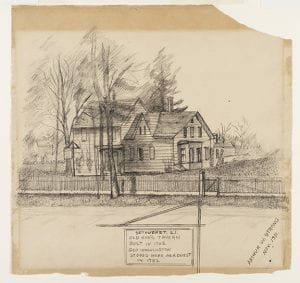
According to census records, Arthur W. Strong was born about 1878. He may have moved from Brooklyn to Port Jefferson in November 1911 at about age 32, when he completed his first sketch, which was of the tavern.
Strong’s sketches appear to have been done during his commissions as a sign painter, and he returned to the tavern on three occasions. The first sketch, drawn in 1911, included an inset of what was likely his proposed sign marking Washington’s visit (that Strong mistakenly recorded as occurring in 1782) and not a word about a tea house. Strong’s last three sketches in 1917 depict the front facade of the tavern without any sign; a proposed sign for the ‘Old Tavern Tea House’ with a full-face picture of George Washington and the correct date of his visit in 1790; and Washington’s bedroom. The latter indicates Strong’s interest in interior decorating that ultimately led to his becoming a partner in his own design business by 1930.
Strong’s 1911 sketch is reminiscent of similarly composed views found in photo postcards of the tavern by English-born photographers Arthur S. Greene (1867-1955), who came to Port Jefferson in 1894, and Robert S. Feather (1861-1937) a jeweler and watchmaker who arrived in Smithtown after 1900.
While Greene’s postcard shows a real estate sign on a post like that drawn in Strong’s sketches, Feather’s postcard circa 1916-1918 shows a boxy tea house sign, framing a view taken east of the signpost. Tea houses were a popular venue in 1917: the same year Strong drew Washington’s visage on his Old Tavern Tea House sign for Roe’s, a new tea house was established to the west on Route 25A, at the Roslyn Grist Mill, the oldest Dutch commercial building in the United States (now undergoing extensive restoration by the Roslyn Landmark Society).
Roe Tavern sketches reach N-YHS

Tavern, 1917, by Arthur W. Strong,
gift of the Estate of Oscar T. Barck Sr.
Photography©New-York Historical Society at https://www.nyhistory.org
The N-YHS received Strong’s sketches as a Gift of the Estate of Oscar T. Barck Sr., historian to the Sons of the American Revolution, collector of documents signed by Washington and father of Syracuse University professor and noted historian and author Oscar Theodore Barck Jr. (1902-1993), whose papers and ephemera the N-YHS also houses.
Barck Jr.’s book, “New York City During the War for Independence: With Special Reference to the Period of British Occupation” (1931), provides one of the early discussions of Washington’s spy ring, following Suffolk County historian Morton Pennypacker’s “Two Spies” (1930) identifying Robert Townsend of Oyster Bay as Culper Jr. in prelude to Pennypacker’s “George Washington’s Spies” (1939) establishing Abraham Woodhull of Setauket as Culper Sr.
Pennypacker described how Anna Smith Strong hung laundry on a clothesline to signal Woodhull when and where Capt. Caleb Brewster’s whaleboats beached in various coves to receive messages he would relay across the Sound to Washington’s headquarters. Arthur Strong’s interest in Roe Tavern shows an appreciation for Strong family history in Setauket although his father’s family emigrated to the United States from England in 1851. As “Master Painters,” Arthur Strong’s family established their own business of paper hanging and painting in Manhattan and Brooklyn before Arthur moved to Port Jefferson.
Encoded art and architecture lead to rediscovered sketches
Roe Tavern’s two-story three-bay main section with a door to the right, considered a “half-house,” featured nine-over-six windows, a common yet potentially politically significant configuration, also found in the similar facade of a circa 1752 house once the home of Mary Woodhull Arthur and now owned by the Smithtown Central School District on West Main Street, Smithtown. That suggestive fenestration led me to discover Mary’s father was Abraham Woodhull, aka Culper Sr., one of the Culpers for whom the Spy Trail was named. After leaving Roe’s Tavern on April 23, 1790, Washington traveled to Smithtown past the Arthur House en route to Huntington and dined at Platt’s Tavern, no longer extant, making Mary’s home the only one of the three Washington passed that day still located where it stood in 1790.
The locating of Strong’s Setauket sketches comes in conjunction with my current research into the possibility that architectural features of Roe Tavern, the Arthur House in Smithtown and the wall paintings of the Sherwood-Jayne House in East Setauket could be highly political in nature. Owned by Preservation Long Island, the Sherwood-Jayne House is believed to have been built about 1730 with the east addition housing the paintings dated to circa 1780-1790. Without giving away details, I’ll say the Sherwood-Jayne House would not be the first American home documented with frescoes of a similar style said to have been painted to express loyalty to either a British or American political stance close to the end of the American Revolution.
As a clue to understanding the political potential of the Sherwood-Jayne wall paintings, I’ll remind readers of Abigail Adams’ admonition, “Remember the ladies,” written to her husband, John, at a time when he was helping to frame the Declaration of Independence for the new American government in 1776. Abigail’s advice lends meaning to the ciphers that appear to be spelled out on the interior walls of the Sherwood-Jayne House and are repeated in the fenestration of its front facade as well as the windows of Mary Woodhull Arthur’s home and Roe Tavern.
North Shore arts flourish
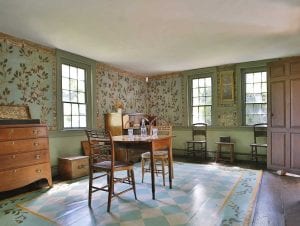
Photo courtesy of Preservation Long Island
Within the 1911 to 1917 time frame that Arthur W. Strong sketched Roe Tavern, painter Emile Albert Gruppé was commissioned in 1916 by antiquarian Howard Sherwood, to restore the wall paintings in a downstairs parlor of his nearby East Setauket home (now the Sherwood-Jayne House).
Sherwood discovered the paintings beneath the wallpaper shortly after purchasing the house in 1908.
Strong and Gruppé were working in the East Setauket area while sculptor Charles Cary Rumsey’s early plaster cast of Whisper, the Smithtown Bull (now at the Smithtown Historical Society), was exhibited, beginning in 1913, at the new Smithtown Library (1912), to raise funds for the five-ton bronze Bull.
Gruppé could have seen the model when he arrived in East Setauket and ironically, in 1919, Emile’s brother, sculptor Karl Gruppé, would become Rumsey’s assistant. After Rumsey’s death in 1922, Karl went to Paris for three years to supervise completion of Rumsey’s unfinished works, which included the Smithtown Bull (National Register Eligible 2018).
It was cast in 1926, shortly after Emile Gruppé returned to the North Shore and recorded, in April 1925, that he restored “with much care,” the second-floor frescoes at Sherwood’s home.
The Bull represents not only the time-honored folklore of Richard “Bull” Smith’s famous ride upon a bull circling the land that would become Smithtown but also stands as the secular symbol of the winged ox attribute of St. Luke, patron of painters and architects.
Standing tall at the junction of Routes 25 and 25A, the bronze Bull installed in Smithtown in 1941 serves as a symbol of the arts along the North Shore from the township of Smithtown to Brookhaven. Little known, but locally significant, Arthur W. Strong, creator of the Roe Tavern Sketches, was a figure in that North Shore arts movement.
About the author: Independent Historian Corey Geske of Smithtown also compared sketches at the N-YHS to an Asher Brown Durand painting at the Grand Rapids Art Museum in Michigan, resulting in its correct re-titling as “View in the Valley of Oberhasle, Switzerland” (1842) in the Art Inventories Catalog of the Smithsonian American Art Museums. Geske proposed a National Register Historic District for downtown Smithtown in early 2017, prepared the report resulting in the Smithtown Bull being determined Eligible for the NR (2018) and wrote the successful nomination for recent listing on the National Register of Historic Places of the Byzantine Catholic Church of the Resurrection (1929) designed by Henry J. McGill and Talbot F. Hamlin, and its Rectory, the former Fred and Annie Wagner Residence (1912) designed by Gustav Stickley.

